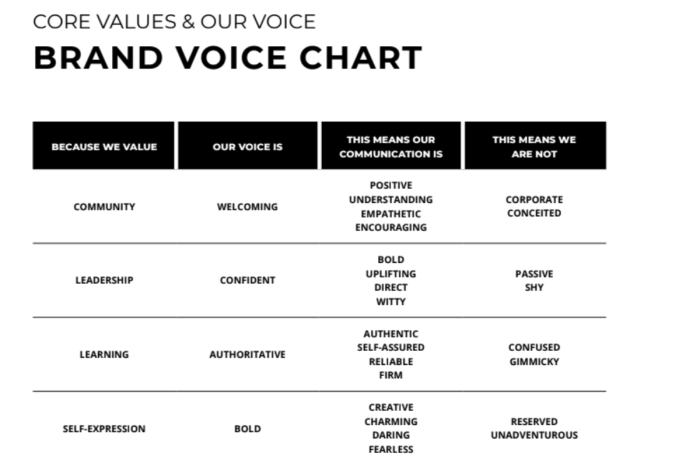Creating a Brand Voice sets the stage for your company’s identity to shine through in a crowded market, showcasing what makes you stand out. From defining what brand voice is to implementing it effectively, this journey is all about making your mark in the business world.
Get ready to dive deep into the world of brand voices and discover how to make yours resonate with your audience like never before.
Importance of Brand Voice
Creating a distinct brand voice is crucial for a company as it helps differentiate the brand from competitors, build a strong identity, and connect with the target audience on a deeper level. A unique brand voice sets the tone for all communication and marketing efforts, making the brand more memorable and recognizable in the crowded marketplace.
Examples of Successful Brands with Unique Brand Voices
- Apple: Known for its minimalist and sleek brand voice, Apple creates a sense of sophistication and innovation, which has helped them build a loyal customer base willing to pay a premium for their products.
- Nike: With a motivational and empowering brand voice, Nike inspires athletes to push their limits and achieve greatness, leading to a strong emotional connection with their customers.
- Coca-Cola: Coca-Cola’s brand voice is all about happiness, joy, and togetherness, resonating with people of all ages and cultures around the world, resulting in strong brand loyalty and recognition.
How Brand Voice Helps in Creating Brand Recognition and Loyalty
A strong brand voice helps in creating brand recognition by consistently communicating the brand’s values, personality, and messaging across all touchpoints. This consistency builds trust and familiarity with customers, making it easier for them to remember and identify the brand in the future. Moreover, a unique brand voice creates an emotional connection with customers, leading to brand loyalty as customers feel more attached to the brand and its values, increasing repeat purchases and advocacy.
Defining Brand Voice

Brand voice refers to the unique personality and tone of a brand that is conveyed through its messaging and communication. It encompasses the values, mission, and characteristics of the brand, shaping how it connects with its audience. Brand voice is crucial in establishing a consistent and recognizable identity in the market.
Components of Brand Voice
- The language and vocabulary used
- The style of communication (formal, casual, humorous, etc.)
- The overall personality projected (friendly, authoritative, innovative, etc.)
- The values and beliefs expressed
Brand Voice vs. Brand Tone
In essence, brand voice is the overall personality of the brand, while brand tone refers to the specific emotions and attitudes conveyed in individual communications. Brand voice sets the foundation for the brand’s identity, while brand tone allows for flexibility and adaptation based on the context or message being delivered. Both are essential in creating a cohesive brand image.
Examples of Brand Voices
- Playful: Brands like Wendy’s and Taco Bell use a playful brand voice to engage with a younger audience and stand out in the fast-food industry.
- Professional: Companies like IBM and Goldman Sachs maintain a professional brand voice to convey trust, expertise, and reliability in the corporate world.
- Quirky: Brands like Ben & Jerry’s and Dollar Shave Club use a quirky brand voice to appeal to a more laid-back and creative consumer base.
Developing a Brand Voice

Creating a brand voice from scratch can be an exciting yet challenging process. It involves defining the personality, tone, and style of your brand’s communication to resonate with your target audience effectively.
Aligning Brand Voice with Company’s Values, Mission, and Target Audience
When developing a brand voice, it is crucial to align it with your company’s values, mission, and target audience. Here are some tips to ensure alignment:
- Understand your company’s values and mission: Start by clearly defining what your brand stands for and the message it wants to convey.
- Know your target audience: Research and understand your target audience’s preferences, behaviors, and communication style to tailor your brand voice accordingly.
- Create brand guidelines: Develop brand guidelines that Artikel the tone, language, and messaging principles to maintain consistency across all communication channels.
- Train your team: Educate and train your team members on the brand voice guidelines to ensure everyone communicates in a unified voice.
Ensuring Consistency in Brand Voice Across Communication Channels
Consistency is key when it comes to brand voice across all communication channels. Here’s how to maintain consistency:
- Use a style guide: Develop a comprehensive style guide that includes examples of the brand voice in action to serve as a reference for all communication materials.
- Regularly review and update: Continuously monitor and update your brand voice guidelines to adapt to changing trends and audience preferences.
- Implement feedback loops: Gather feedback from customers, employees, and stakeholders to ensure that your brand voice resonates with the intended audience.
- Audit your communication channels: Regularly audit your website, social media, advertising, and other communication channels to ensure that the brand voice remains consistent.
Implementing Brand Voice
Implementing the brand voice is crucial to ensure consistency and authenticity across various marketing materials. It involves effectively communicating the brand’s personality and values through every interaction with customers.
Utilizing Brand Voice in Marketing Materials
- Ensure social media posts reflect the brand’s tone, language, and values.
- Craft website content that resonates with the brand voice, maintaining a cohesive message.
- Create advertisements that align with the brand’s personality, using consistent messaging and visuals.
Training Employees for Brand Voice Alignment
- Provide employees with clear guidelines on the brand voice, including examples and best practices.
- Offer training sessions to help staff understand and embody the brand’s tone and values.
- Encourage employees to practice using the brand voice in their interactions with customers.
Adapting Brand Voice for Different Platforms
- Adjust the brand voice to suit the unique characteristics of each platform while maintaining overall consistency.
- Tailor the tone and language of the brand voice to resonate with the target audience on specific platforms.
- Monitor and assess the effectiveness of the brand voice on different platforms, making adjustments as needed.
Brand Voice and Customer Engagement: Creating A Brand Voice
In the world of branding, having a well-defined brand voice is crucial for enhancing customer engagement and building strong relationships with your audience. Your brand voice is what sets you apart from your competitors and helps customers connect with your brand on a deeper level.
The Power of Authenticity
- Being authentic in your brand voice can help customers feel like they are interacting with a real person rather than a faceless corporation. This humanizes your brand and creates a sense of trust and loyalty.
- One great example of a brand that has successfully used its brand voice to connect with customers is Wendy’s. Known for its witty and sassy social media presence, Wendy’s engages with its audience in a fun and relatable way, making customers feel like they are part of the conversation.
- By staying true to their brand voice and injecting humor into their interactions, Wendy’s has been able to create a strong emotional connection with their customers, leading to increased engagement and brand loyalty.
The Art of Storytelling, Creating a Brand Voice
- Storytelling plays a significant role in amplifying your brand voice and resonating with your target audience. By sharing compelling stories that evoke emotion and connect with customers on a personal level, you can create a lasting impact and build a loyal following.
- A prime example of a brand that excels in storytelling to enhance customer engagement is Nike. Through powerful ad campaigns and inspiring narratives, Nike has been able to connect with customers on a deeper emotional level, motivating them to strive for greatness and embody the brand’s values.
- By leveraging storytelling as a tool to communicate their brand voice, Nike has successfully built a community of loyal fans who not only purchase their products but also advocate for the brand and its mission.





